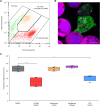Eating the brain - A multidisciplinary study provides new insights into the mechanisms underlying the cytopathogenicity of Naegleria fowleri
- PMID: 40096149
- PMCID: PMC11964265
- DOI: 10.1371/journal.ppat.1012995
Eating the brain - A multidisciplinary study provides new insights into the mechanisms underlying the cytopathogenicity of Naegleria fowleri
Abstract
Naegleria fowleri, the causative agent of primary amoebic meningoencephalitis (PAM), requires increased research attention due to its high lethality and the potential for increased incidence as a result of global warming. The aim of this study was to investigate the interactions between N. fowleri and host cells in order to elucidate the mechanisms underlying the pathogenicity of this amoeba. A co-culture system comprising human fibrosarcoma cells was established to study both contact-dependent and contact-independent cytopathogenicity. Proteomic analyses of the amoebas exposed to human cell cultures or passaged through mouse brain were used to identify novel virulence factors. Our results indicate that actin dynamics, regulated by Arp2/3 and Src kinase, play a considerable role in ingestion of host cells by amoebae. We have identified three promising candidate virulence factors, namely lysozyme, cystatin and hemerythrin, which may be critical in facilitating N. fowleri evasion of host defenses, migration to the brain and induction of a lethal infection. Long-term co-culture secretome analysis revealed an increase in protease secretion, which enhances N. fowleri cytopathogenicity. Raman microspectroscopy revealed significant metabolic differences between axenic and brain-isolated amoebae, particularly in lipid storage and utilization. Taken together, our findings provide important new insights into the pathogenic mechanisms of N. fowleri and highlight potential targets for therapeutic intervention against PAM.
Copyright: © 2025 Malych et al. This is an open access article distributed under the terms of the Creative Commons Attribution License, which permits unrestricted use, distribution, and reproduction in any medium, provided the original author and source are credited.
Conflict of interest statement
The authors have declared that no competing interests exist.
Figures






References
-
- Carrasco-Yepez M, Campos-Rodriguez R, Godinez-Victoria M, Rodriguez-Monroy MA, Jarillo-Luna A, Bonilla-Lemus P, et al.. Naegleria fowleri glycoconjugates with residues of α-D-mannose are involved in adherence of trophozoites to mouse nasal mucosa. Parasitol Res. 2013;112(10):3615–25. doi: 10.1007/s00436-013-3549-2 - DOI - PubMed
MeSH terms
Substances
LinkOut - more resources
Full Text Sources
Miscellaneous

